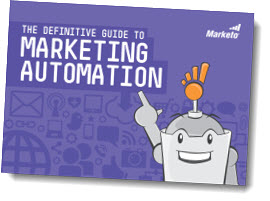Recently I was asked to contribute some thoughts to Marketo’s new ebook, “The Definitive Guide to Marketing Automation.” You can download a free copy of the ebook – 100 pages on everything you need to know about marketing automation – what it is, how it’s different from CRM, common features, keys to success, and more – by clicking here. Below is my contribution (see Page 71.)

What are the most important things to look for in a marketing automation vendor?
HS: Here are the questions I’d ask:
1. How many FT employees (or equivalents) am I going to need to manage the system?
2. How easy is it to customize the system to our specific business model and/or sales process?
3. How easy is it to change or modify programs if our sales process changes?
4. How often do you release product enhancements?
5. How quickly can I be up and running?
What do you think the future of marketing automation will look like in the next few years?
HS: I see marketing automation becoming a more mission-critical piece of the IT landscape. For example, look for integration with other systems beyond CRM (e.g. Finance, ERP). Marketing is increasingly ROI-driven, and marketing automation can be not only the platform to provide that measurement, but the engine that drives company revenue. Technology that was only recently regarded as “email software” is now becoming a vital component of a company’s sales and marketing infrastructure.
What are the most important things you have to keep in mind in order to be successful with marketing automation?
HS: #1 is: Have a plan. It sounds so basic, and yet it’s the primary reason why many companies don’t achieve the value they should from marketing automation. So often, new MA customers have a pent-up demand for campaigns, so they immediately launch into a series of “one-off” programs and never take the time to ask the question: what is it exactly that we want marketing automation to do for us? My advice: don’t just be a “campaign factory.” Have a strategy in place and orient your use of the technology (and the programs you design) towards specific sales, marketing, and business goals.
What are some benefits of marketing automation that you would point out to someone who is considering switching from their Email Service Provider (ESP)?
Aside from enhanced revenue and ROI tracking, the biggest difference for companies making the transition from an ESP will be the ability to create automated, multi-step, triggered campaigns. ESP users are primarily limited to manual, one-off batch programs, whereas with marketing automation, you can target prospects much more precisely, create branching campaigns that send different messages depending on someone’s response or behavior, and time your campaigns on a one-to-one basis; the possibilities are endless.
What should you focus on when selling marketing automation your executive team? What are some things that might resonate with a CEO, CFO, or sales?
HS: Be wary of offering generic benefits like “increased marketing ROI” or “shorter selling cycles.” Those benefits may be legitimate possibilities, but they carry less weight when they could apply to any organization. Instead, identify the most pressing sales and marketing challenges at your company, and speak to those specific issues. For example:
• Increase the rate at which users upgrade from our freemium version to a paid license
• Increase the rate and volume of qualified leads passed to field sales
• Enhance our demand generation effectiveness by optimizing program spend based on true ROI
• Increase the number of pipeline opportunities by more effectively marketing to existing leads
• Increase the efficiency and bandwidth of inside sales without adding headcount
Disclaimer: Spear Marketing Group is a Preferred Services Partner of Marketo.
